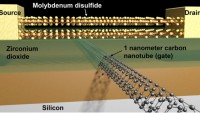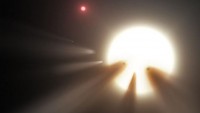Scientists Aim to Forecast Eruptions by Better Detecting Volcanic Carbon Emissions
| Arthur Dominic Villasanta | | Oct 08, 2016 10:45 AM EDT |
(Photo : Trial by Fire 2016) Scientists measuring gases emitted by a volcano.
A new app developed by scientists showing the close link between volcanoes and earthquakes will also help bring them closer to the cherished goal of being able to predict volcanic eruptions by better measuring the degassing of carbon dioxide occurring before an eruption.
Called E3, the app allows users to see the last 50 years of eruptions, earthquakes and emissions with one click.
Like Us on Facebook
"This app is interesting not only for educators and the public, but also will help scientists understand global eruption patterns and linkages between Earth's inner workings and the air we breathe," said Elizabeth Cottrell, head of the Global Volcanism Program of the Smithsonian Institution in Washington, DC.
E3 allows users to select and learn about individual eruptions, emissions and earthquakes, as well as their collective impact. It visualizes these huge global datasets together for the first time, and users can speed or slow or stop the passage of time.
"We're getting more and more confident that changes in the carbon to sulfur ratio precede eruptions," said Maarten de Moor from the National University in Costa Rica.
"Potentially, we can now see an eruption coming just by looking at gas emissions. What is truly fascinating is how dynamic these volcanoes are in their degassing and eruptive behavior. To understand the big picture of Earth degassing, we also need to understand the processes driving temporal variations in volcanic emissions."
Data from Smithsonian's Global Volcanism Program and the United States Geological Survey (USGS) feed into the app. The datasets are available for free download. The app will update continuously, accumulating new events and additional historical information as it becomes available.
A team of experts developed the app with support from the Smithsonian Institution and the Deep Carbon Observatory (DCO), an international multidisciplinary research program exploring the quantities, movements, forms, and origins of carbon deep inside Earth.
DCO scientists are studying volcanic emissions as part of this mission, and will more than triple the number of permanent volcano gas monitoring stations from 2012-2019.
Recent discoveries by DCO scientists in the Deep Earth Carbon Degassing (DECADE) initiative are laying the foundation for improved volcanic eruption forecasts.
"We are deploying automated monitoring stations at volcanoes around the world to measure the gases they emit," said Tobias Fischer, a volcanologist at the University of New Mexico, USA, and leader of DECADE.
"We measure carbon dioxide, sulfur dioxide, and water vapor (steam), the major gases emitted by all volcanoes on the planet. In the hours before an eruption, we see consistent changes in the amount of carbon dioxide emitted relative to sulfur dioxide.
"Keeping an eye on the ratios globally via satellites and on-site monitoring helps us learn the precursors of volcanic eruptions. Monitoring these volcanic gas variations also helps us come up with a more accurate estimate of total volcanic carbon dioxide emissions on Earth -- a major goal of DCO."
"Our goal of tripling the number of volcanoes monitored around the world by 2019 is no small task," added Fischer. "Installing instruments on top of volcanoes is dangerous work in extremely hard-to-reach places."
By 2019, DECADE scientists hope to have gas monitoring stations on 15 of the world's 150 most active volcanoes. This will add to the eight stations currently operated by other entities such as the USGS and the University of Palermo (Italy).
Data collected at these monitoring stations are feeding a new database of volcanic carbon emissions, making potentially life-saving information available to many more scientists around the world.
To assess volcanic activity and gas release on a global scale, DCO researchers at the University of Cambridge, UK, are taking yet another approach; measuring volcanic gases from space using satellites.
"With satellites, we have been able to measure sulfur dioxide emissions for years and the technology keeps getting better," said Marie Edmonds, co-chair of DCO's Reservoirs and Fluxes Science Community.
"An exciting new aspect of DCO's research combines the satellite data with ground-based measurements of carbon to sulfur ratios provided by DECADE. This powerful combination allows us to better define global volcanic emissions, or degassing, of carbon dioxide."
TagsE3, Volcano, volcanic eruptions, degassing, carbon dioxide, earthquakes, Deep Carbon Observatory, Deep Earth Carbon Degassing
©2015 Chinatopix All rights reserved. Do not reproduce without permission
EDITOR'S PICKS
-

Did the Trump administration just announce plans for a trade war with ‘hostile’ China and Russia?
-

US Senate passes Taiwan travel bill slammed by China
-

As Yan Sihong’s family grieves, here are other Chinese students who went missing abroad. Some have never been found
-

Beijing blasts Western critics who ‘smear China’ with the term sharp power
-

China Envoy Seeks to Defuse Tensions With U.S. as a Trade War Brews
-

Singapore's Deputy PM Provides Bitcoin Vote of Confidence Amid China's Blanket Bans
-

China warns investors over risks in overseas virtual currency trading
-

Chinese government most trustworthy: survey
-

Kashima Antlers On Course For Back-To-Back Titles
MOST POPULAR
LATEST NEWS
Zhou Yongkang: China's Former Security Chief Sentenced to Life in Prison

China's former Chief of the Ministry of Public Security, Zhou Yongkang, has been given a life sentence after he was found guilty of abusing his office, bribery and deliberately ... Full Article
TRENDING STORY

China Pork Prices Expected to Stabilize As The Supplies Recover

Elephone P9000 Smartphone is now on Sale on Amazon India

There's a Big Chance Cliffhangers Won't Still Be Resolved When Grey's Anatomy Season 13 Returns

Supreme Court Ruled on Samsung vs Apple Dispute for Patent Infringement

Microsoft Surface Pro 5 Rumors and Release Date: What is the Latest?














